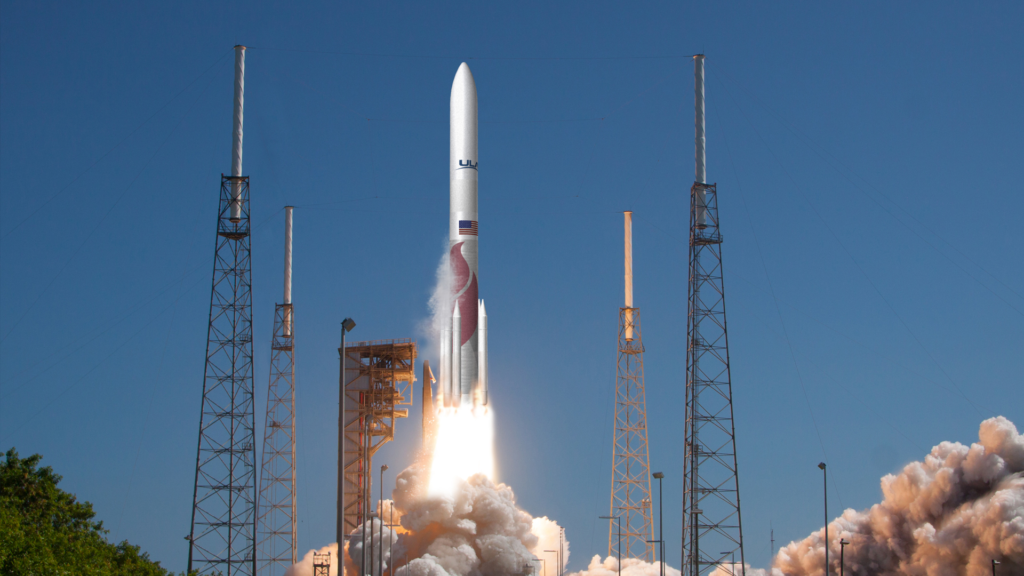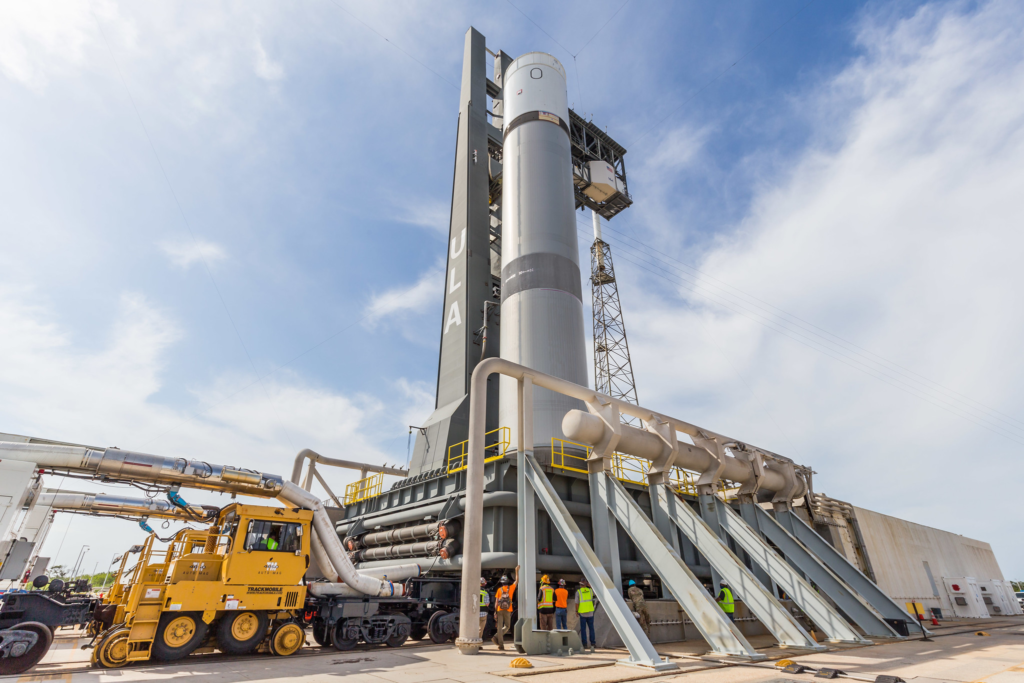
ULA Just Needs One More BE-4 Engine Before Vulcan Is Ready
Over time United Launch Alliance has managed to build up one of the most impressive launch records within the space industry. The company’s commitment to launching on time and without errors is part of the reason why they have had so much success. A history they plan to keep up with their newest next generation launch vehicle Vulcan.
Since 2014, ULA has been working on a vehicle meant to replace the workhorses responsible for practically all the company’s launches up until now. Over the past few months, we have been provided updates on the rocket as it approaches it’s first ever launch attempt. Specifically, just two days ago CEO of ULA Tory Bruno provided exciting information and images relating to this first launch.
Currently, the rocket which relies on two Blue Origin BE-4 engines for the majority of thrust, has one installed and just needs one more. While there have been quite a few delays in the past few years regarding these engines, we are just a few months away from seeing them in action for the first time. Here I will go more in-depth into Vulcan’s progress, the upcoming launch attempt, the launch vehicle design, and more.
Recent Progress

The last few weeks alone have been filled with updates regarding Vulcan and its first launch. A lot of which has to do with the BE-4 engines as they are the final piece needed before the rocket is off for testing. On October 17th Tory Bruno tweeted saying, “That is a beautiful sight! One more BE4 and he’s off to the Cape.” This included an image of the Vulcan first stage with one BE4 installed. For months now both Blue Origin and Tory Bruno have provided the occasional update on the two BE-4 flight engines as they progressed through development and testing. The engine already installed on the Vulcan is Flight Engine #1. This engine was delivered to ULA just days prior and is already integrated onto the launch vehicle. Specifically, on October 10th, Tory Bruno tweeted mentioning, “Hmm. What’s that? Looks like a BE4 flight engine being uncreated at the Rocket Factory in Decatur…”
With the first flight engine already delivered and installed on Vulcan, this brings up the question of what progress has been made on the second engine and when should we expect to see it delivered. The most recent news regarding Flight Engine #2 came a couple of weeks ago in late September. In this case, Tory Bruno tweeted pointing out, “Found it! Ok, since you asked so nicely… here is a full duration @BlueOrigin#BE4 firing.” He went on to clarify that “This is an Acceptance Test Firing of the FE2 First flight engine.”
However, when comparing these two flight engines, its been clear throughout time that Flight Engine #2 has always been a bit behind Flight Engine #1. For example, starting in early July this year, Tory Bruno tweeted saying, “You guys have clearly revealed yourselves to be passionate about space. So, here’s a bonus picture just because you’re awesome: two #BE’s at once in @blueorigin ‘s Kent Factory.” In this image, you can see the difference in development between Flight Engine 1 on the right and Flight Engine 2 on the left. For one last example, later that same month another tweet highlighted, “Wow. You guys really do like seeing rocket engines. OK, Flight Engine #1 (fully assembled) on the left. #2 (almost done) on the right.” This helps put in perspective the difference in progress between the two.
While noticeable, Flight Engine #2 is not very far behind at all. With the recent updates on its successful testing and more, we can expect this engine to be ready and delivered likey in just a few weeks. Once delivered, as Tory originally said, it will be installed and Vulcan will be headed to the Cape for integration, final testing, and the official first launch. As far as Vulcan’s progress not relating to the engines, practically everything is ready. In late September Tory Bruno was asked about the vehicle’s progress and replied, “Booster is done and waiting. Centaur V is just finishing up finals and will be waiting momentarily. PLF is basically done. Pad is ready to go. Astrobotics is making good progress. All of which suggests a launch only a few months away in early 2023 is going to happen.
Vulcan Centaur Overview

Now that we know more about the final engine ULA is waiting on and its next steps, we can take a closer look at the launch vehicle itself and what makes it unique. The Vulcan Centaur is a two-stage, heavy-lift launch vehicle that has been under development by United Launch Alliance since 2014. Standing over 60 meters tall and capable of launching up to 27,000 kilograms into low Earth orbit, Vulcan is quite a big rocket. The Vulcan Centaur rocket design leverages the flight proven success of the Delta IV and Atlas V launch vehicles while introducing new technologies and innovative features to ensure a reliable and affordable space launch service. Vulcan is expected to service a diverse range of markets including commercial, civil, science, cargo, and national security space customers.
The rocket has already secured some major future launch contracts including one with Amazon. Specifically, in April this year, ULA announced that Amazon had selected its next-generation Vulcan rocket for 38 launches supporting deployment for its ambitious Project Kuiper, Amazon’s initiative to increase global broadband access through a constellation of 3,236 advanced satellites in low Earth orbit. At the time Tory Bruno commented, “We strongly believe in the mission of Project Kuiper. We are honored to be entrusted with the majority of Amazon’s launches with a total of 47 missions, including the nine Atlas launches already on contract. At ULA we are focused on serving our customers and partnering with them to provide unmatched flight capabilities and mission operations and assurance, to provide the lowest risk and best-value launch solution.”
Focusing back on the rocket itself, the bottom of the first stage features two BE-4 engines producing around 550,000 pounds of thrust at sea level. In addition, Vulcan integrates up to six Northrop Grumman Graphite Epoxy Motor (GEM) 63XL Solid Rocket Boosters (SRBs). They are constructed out of a graphite-epoxy composite with the throttle profile designed into the propellant grain. GEM solids supported the Delta II and Delta IV rockets, and the GEM 63 variant will fly on ULA’s Atlas V rocket prior to the first Vulcan launch. Depending on the amount of additional SRBs, the rocket has a wide variety of payload capacities to try and meet different mission requirements. Moving to the upper stage, Vulcan will rely on two RL10C engines to power its second stage. Logging an impressive record of nearly 400 successful flights and nearly 700 firings in space, RL10 engines, manufactured by Aerojet Rocketdyne, harness the power of high-energy liquid hydrogen. The RL10 boasts a precision control system and restart capability to accurately place payloads into orbit.
At the very top, the spacecraft is encapsulated in a 5.4-m- (17.7-ft-) diameter payload fairing (PLF), a sandwich composite structure made with a vented aluminum-honeycomb core and graphite-epoxy face sheets. The bisector (two-piece shell) PLF encapsulates the spacecraft. The payload attach fitting (PAF) is a similar sandwich composite structure creating the mating interface from spacecraft to upper stage. The PLF separates using a debris-free horizontal and vertical separation system with spring packs and frangible joint assembly. The payload fairing is available in the 15.5 m (51 ft) standard and 21.3 m (70 ft) long configurations.
In terms of flight readiness, around one year ago, ULA successfully completed the initial round of pathfinder activities at Cape Canaveral by performing a countdown test on Tuesday, Oct. 5 to rehearse all aspects of launch day operations. The flight-configuration Vulcan core stage, named the Pathfinder Tanking Test (PTT ) booster, was transported 2.7 miles (4.3 km) from the Spaceflight Processing Operations Center to Space Launch Complex (SLC)-41 aboard the Vulcan Launch Platform (VLP) on Monday, Oct. 4. This same PTT booster will fly to space on a later mission. It is fitted with two development BE-4 engines, which were extensively hot fired and will be replaced with flight engines prior to launch. The rocket systems were powered up and tested while a separate team of technicians at SLC-41 configured the pad for cryogenic fueling operations. At T-minus 3 hours, the countdown entered a planned hold to clear the launch complex and poll launch controllers to verify readiness to proceed into fueling. ULA Launch Director Lou Mangieri authorized the “go” to continue the test. ULA commented that “Tuesday’s experience proved the extensive effort to design and build the next-generation launch system is moving ever closer to the inaugural flight. The accomplishment of a successful countdown test also signals the conclusion of the first set of PTT activities.”
Conclusion
United Launch Alliance is only a few months away from the long-awaited first launch of Vulcan. As of right now, one BE-4 engine is installed and the company is waiting on the second before moving the rocket to the pad. Based on updates over the past few months, this engine will likely arrive within a few weeks from now. We will have to wait and see how it progresses and the impact it has on the space industry.